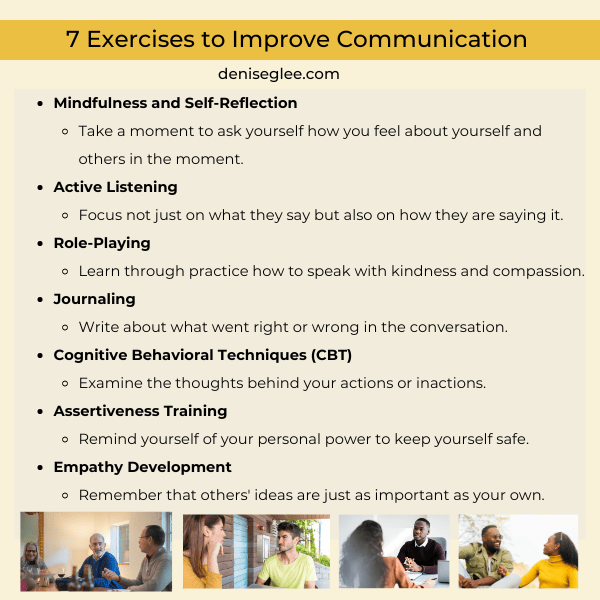
Poor Communication: Recognize Manipulative & Deceptive Words
- Updated: September 17, 2024
Have you ever been around someone who said something that didn’t feel right, but you agreed with them anyway? If so, you’ve experienced poor communication.
As an healing and leadership coach, my goal is to help you talk with others at work and in your personal life with ease and less drama. That’s why in this post we will discuss how to spot manipulation, understand why someone might use tricky or harsh words, and how to fix poor communication.
Before we go further, I want to talk with you about conversational rape, which this content is based on.
Conversational Rape
Dr. Patricia Allen, known affectionately as Dr. Pat, is a family and child therapist who has spent the past 40 years helping people understand the power of the words they use. One of her lesser-known books is called Conversational Rape. In this book, she explains how people use words to deceive, mislead, and threaten others into doing things they otherwise wouldn’t. This is a form of emotional violence that, if done repeatedly, can rob people of their spiritual and emotional well-being.
Note: Dr. Allen uses this term, but it’s not commonly used in mainstream psychology or communication studies. This term is controversial and not widely accepted when talking about harmful communication patterns. So, we will use the term “poor communication” in this post.
There are no winners in poor communication patterns. Both the speaker and listeners are trapped in a dysfunctional communication style that distorts reality. Listeners might believe the speaker is all-powerful, while the speaker falsely believes in their ability to control and manipulate others. This can escalate to the point where their behavior could harm others and result in legal consequences.
Now, let’s talk about what it looks like for a business person to suffer from decades of poor communication habits.
From Moguls to Downfalls: The Spectacular Crashes of Sean Combs and Bill Hwang Due to Deception and Manipulation
Two well-known business figures who fell from grace due to repeated dishonesty and manipulation are Sean Combs and Bill Hwang.
Sean Combs
Sean “Diddy” Combs, the music mogul once at the top of the hip-hop world, is now facing some seriously disturbing charges—like, “how did we even get here?” level serious.
On September 17, 2024, Diddy was hit with an indictment that reads like a crime drama. He’s being accused of running a sex-trafficking ring, with prosecutors saying he hosted “freak offs”—yes, that’s actually what they called it—for over a decade. These weren’t your average wild parties; according to the indictment, these involved some truly shocking stuff.
The accusations? He and his crew allegedly lured women into his circle, where they were forced or coerced into sex acts. To keep everyone quiet, Diddy reportedly recorded these “events” and used the footage as leverage. Let’s just say, this is not the comeback tour anyone expected.
Prosecutors also claim he handed out controlled substances like party favors to keep the women “obedient.” So now, at 54, instead of adding more platinum records to his name, Diddy’s looking at charges for racketeering, sex trafficking, and transporting for prostitution. Talk about a plot twist.
His lawyer, Marc Agnifilo, insists that while Combs isn’t perfect, he’s no criminal. Apparently, Combs has been cooperative with the investigation, even moving to New York a week before his arrest, probably thinking, “Well, better get ahead of this mess.”
And back in March 2024, the Department of Homeland Security raided his homes in Los Angeles and Miami as part of a human trafficking investigation. According to the prosecutors’ report, authorities found “freak off supplies,” which included drugs and over 1,000 bottles of baby oil and lubricant.
Combs shot to fame in the ‘90s as Puff Daddy, later changing his name to P. Diddy, then Diddy. (Who knows what’s next? Just “P”?) His record label, Bad Boy Records, was a big deal, signing stars like Faith Evans and the Notorious B.I.G. He used that fame to build a business empire, selling clothes, alcohol, and cologne.
USA Damian Williams: Earlier this evening, federal agents arrested Sean Combs, based on a sealed indictment filed by the SDNY. We expect to move to unseal the indictment in the morning and will have more to say at that time.
— US Attorney SDNY (@SDNYnews) September 17, 2024
From Mogul to Mess
But things have really fallen apart lately. Combs stepped down as chairman of Revolt, the TV network he co-founded, and sold his stake. In November 2023, his ex-girlfriend, Cassandra “Cassie” Ventura, accused him of physical and emotional abuse that lasted nearly 10 years. They settled the lawsuit the next day, but that opened the floodgates for more lawsuits, including one from a man.
On top of that, his business deals took a hit. A charter school in New York that he helped create said, “No thanks,” and he stopped promoting Ciroc vodka, which he had been the face of for 20 years. Even Macy’s decided to phase out his Sean John clothing line – and that was before all this went down. Bad times all around.
In December 2023, Combs went on social media saying none of the awful things people are saying about him are true. But with everything going on, it’s safe to say his business empire is in serious trouble – and it’s definitely not a “Diddy” bit funny.
Bill Hwang
Bill Hwang, the founder of Archegos Capital Management, provides a concrete example of how deception in business can lead to catastrophic consequences such as:
- Massive fraud: Hwang orchestrated a $100 billion fraud scheme that unraveled within days, impacting numerous stocks and Wall Street entities.
- Deceptive practices: He secretly amassed outsized stakes in multiple companies without actually holding their stock, misrepresenting Archegos’ positions to banks to secure substantial loans.
- Market manipulation: Prosecutors accused Hwang of artificially inflating stock prices through illicit means.
- Instructing employees to deceive: Hwang directed Archegos employees to mislead banks and manipulate stock prices, disregarding established regulations.
- Legal consequences: Hwang now faces charges of fraud, market manipulation, and racketeering conspiracy. If convicted, he could face a lengthy prison sentence.
I hope these examples of Combs and Hwang show how serious the consequences can be for constant lying and manipulation in business. Their stories demonstrate how such behavior can lead to legal problems, damage to one’s reputation, and the collapse of successful businesses.
Now, let’s talk about how someone would communicate poorly. I have talked with many clients over the years who didn’t realize how badly they were treated until they lost money, respect, and were plunged into a black abyss of poor self-esteem and low confidence.
Types of Poor Communication Habits

Seduction and threats are the main types of poor communication habits that cause confusion, frustration, and pain. Here is an overview of each type. In the next section, we will talk about what that looks like in detail.
- Seduction: Seduction in communication involves using indirect tactics such as guilt, shame, flattery, vagueness, and implied weakness to manipulate others into compliance.
- Threats: Threats involve using fear or potential harm to force someone into compliance. This can include emotional, physical, or sexual violence, as well as threats of abandonment, neglect, or withholding needed help or services.
Seduction

When I talk with people about seduction, they instantly think about it from a sexual context, using words or behavior to imply desire or romance. But seduction is not just about luring someone into bed. Rather, it is about getting someone to do something without using physical force or threats. It is about knowing what motivates someone into action. Let’s talk about what that looks like:
Types of Seduction:
- Guilt: Making someone feel responsible for your problems or needs.
- Example: “If you don’t help me with this, I’ll fail, and it will be all your fault.”
- Shame: Making someone feel bad about themselves to get what you want.
- Example: “I can’t believe you wouldn’t help me; what kind of friend are you?”
- Flattery: Using excessive praise to manipulate someone.
- Example: “You’re so smart and always do things perfectly. Can you do this for me?”
- Evasiveness: Avoiding responsibility in order to make someone else take action.
- Example: After he or she repeatedly ignores your requests, you finally take charge of the situation.
- Implied Weakness: Suggesting that you are too weak or incapable of handling something.
- Example: “I’m really bad at this, and I don’t want to mess it up. Can you do it instead?”
This wraps up the different types of seduction. Let’s talk about the next form of poor communication: threats.
Threats

”If you don’t do what I want, then…”
Threats are powerful because the speaker doesn’t even have to carry out their action. Their loud voice, tall stature, or intimidating stares can get you to fall in line without skipping a beat. And in those moments it can feel next to impossible to be calm. It’s even worse if they hold significant power or influence in your life. Let’s get into some examples of threats:
Different Types of Threats or Proposed Harms:
Using Emotional Violence: Threats that harm someone’s mental or emotional state, including financial health if the person can limit your wealth or access to any valuable asset or resource.
- Example: “If you don’t do this, I’ll make sure everyone knows how terrible you are.”
Hinting at Future Physical/Sexual Violence: Threatening physical harm to force compliance.
- Example: “If you don’t comply, I’ll assault you.”
Withholding Needed Help or Services: Making the other person feel they have no choice but to comply to get the help they need.
- Example: “If you don’t do what I want, I’ll leave you.” This threat uses fear of abandonment to control the partner’s actions.
You may be reading all of this and think to yourself, “Why would someone speak or treat another so poorly?” The answer is multifaceted. In the next section, we will talk about the causes of poor communication.
Causes of Poor Communication

Like anything else in life, there is no one singular reason. Like a multi-car crash, poor communication often happens for several reasons at once. Just as one distracted driver can cause a collision, poor communication can happen when someone’s internal “distractions” lead them to crash into others in conversations.
Here are nine reasons for poor communication or outright manipulation. It’s important to know that multiple factors can affect a person’s communication at the same time.
Rigid Household Dynamics:
- Authoritarian Parenting: In families where strict rules were enforced without caring about children’s feelings, individuals often learn to fear rejection. This fear can lead them to use indirect methods, like seduction or intimidation, in relationships.
Leaderless Household Dynamics:
- Role Reversal: In families where children had to take care of emotionally unstable parents, they might use manipulation (seduction) or force (intimidation) to handle the chaos.
Trauma and Abuse:
- Defense Mechanism: People who have experienced trauma or abuse might use poor communication as a way to protect themselves, often through manipulation or aggression.
Lack of Social Skills:
- Inadequate Socialization: Some people might not have learned proper social skills and could end up using manipulative or aggressive tactics because they don’t know how to communicate well.
Mental Health Issues:
- Psychological Conditions: Conditions like personality disorders or anxiety can lead to poor communication. These issues may make interactions seem more threatening or create a need for control.
Cultural and Societal Influences:
- Cultural Norms: Different cultures have different communication styles. In some cultures, indirect communication is common, leading to subtle manipulation or avoidance.
Low Self-Esteem:
- Insecurity: People with low self-esteem may struggle to express their needs openly and might use manipulation or threats to assert themselves.
Learned Behavior:
- Role Modeling: Children often copy what they see at home. If they see manipulative or aggressive communication from their parents, they might adopt these habits.
Stress and Overwhelm:
- Desperation: High stress or feeling overwhelmed can push people to use poor communication out of frustration or desperation.
7 Exercises to Improve Communication

Just as we learned poor communication habits, we can also learn new, better ones. For each tip I explain how to do it and how it will help you.
As you read through these tips, notice which ones you already use and which ones you might need to work on. Often, improving these areas can be very helpful because they are underdeveloped.
Mindfulness and Self-Reflection:
Take a moment to ask yourself how you feel about yourself and others in the moment. Learn to settle yourself and feel calm and present with yourself.
- Practice: Reflect daily on your interactions. Ask yourself if you were honest and direct or if you used manipulation or threats.
- Goal: Become more aware of your communication patterns to spot when you use poor strategies.
Active Listening:
Focus not just on what they say but how they are saying it. Also, be slow to speak and resist the temptation to perceive their opinions as personal attack on your personal worth.
- Practice: Focus on really understanding what the other person is saying without planning your response while they talk.
- Goal: Improve your ability to respond genuinely and reduce the chance of using manipulative tactics.
Role-Playing:
Learn through practice how to speak with kindness and compassion.
- Practice: With a trusted friend or therapist, role-play different scenarios where you practice honest communication.
- Goal: Build confidence in using healthy communication techniques in real situations.
Journaling:
Write about what went right or wrong in the conversation.
- Practice: Keep a journal of your daily interactions. Note when you felt tempted to use manipulation or threats and explore why.
- Goal: Understand your triggers and develop better responses for the future.
Cognitive Behavioral Techniques (CBT):
Examine the thoughts behind your actions or inactions.
- Practice: Work with a therapist or coach to identify and challenge negative thought patterns that lead to poor communication.
- Goal: Replace harmful communication habits with positive ones.
Assertiveness Training:
Remind yourself of your personal power to keep yourself safe.
- Practice: Do exercises to help you express your needs clearly and respectfully, without manipulation or aggression.
- Goal: Learn to communicate assertively and reduce reliance on poor strategies.
Empathy Development:
Remember that others’ ideas are just as important as your own.
- Practice: Make an effort to understand and validate others’ feelings during interactions.
- Goal: Build a deeper connection and lessen the use of manipulative tactics.

Final Thoughts
I hope these tips help you recognize and change poor communication habits. Remember, today is a new day to start being honest with yourself and others. Practice makes perfect, so don’t worry if you make mistakes along the way.
What have you done to keep yourself emotionally safe from harmful behavior? I’d love to know! Use this link to share your thoughts.
If you need more help, feel free to contact me. Also, check out this episode from my entrepreneur podcast for more insights.






